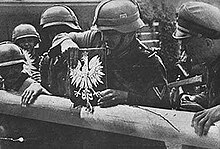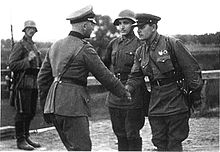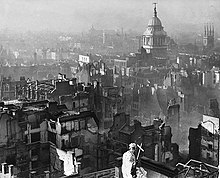![]() Published in Georgia - Social interactions and entertainment - 10 Jun 2016 03:52 - 3
Published in Georgia - Social interactions and entertainment - 10 Jun 2016 03:52 - 3
Course of the warWar breaks out in Europe (1939–40)
On 1 September 1939, Germany invaded Poland under the false pretext that the Poles had carried out a series of sabotage operationsagainst German targets near the border. Two days later, on 3 September, after a British ultimatum to Germany to cease military operations was ignored, Britain and France, followed by the fully independent Dominions of the British Commonwealth—Australia (3 September), Canada (10 September), New Zealand (3 September), and South Africa (6 September)—declared war on Germany. However, initially the alliance provided limited direct military support to Poland, consisting of a cautious, half-hearted French probe into the Saarland. The Western Allies also began a naval blockade of Germany, which aimed to damage the country's economy and war effort. Germany responded by ordering U-boat warfare against Allied merchant and warships, which was to later escalate into the Battle of the Atlantic.
 Soldiers of the German Wehrmachttearing down the border crossing between Poland and the Free City of Danzig, 1 September 1939
Soldiers of the German Wehrmachttearing down the border crossing between Poland and the Free City of Danzig, 1 September 1939
On 17 September 1939, after signing a cease-fire with Japan, the Soviets invaded Poland from the east. The Polish army was defeated and Warsaw surrendered to the Germans on 27 September, with final pockets of resistance surrendering on 6 October. Poland's territory was divided between Germany and the Soviet Union, with Lithuania and Slovakia also receiving small shares. After the defeat of Poland's armed forces, the Polish resistance established an Underground State and a partisan Home Army.About 100,000 Polish military personnel were evacuated to Romania and the Baltic countries; many of these soldiers later fought against the Germans in other theatres of the war. Poland's Enigma codebreakers were also evacuated to France.On 6 October Hitler made a public peace overture to Britain and France, but said that the future of Poland was to be determined exclusively by Germany and the Soviet Union. Chamberlain rejected this on 12 October, saying "Past experience has shown that no reliance can be placed upon the promises of the present German Government." After this rejection Hitler ordered an immediate offensive against France, but bad weather forced repeated postponements until the spring of 1940.
 German Panzer I tanks near the city of Bydgoszcz, during the Invasion of Poland, September 1939
German Panzer I tanks near the city of Bydgoszcz, during the Invasion of Poland, September 1939
fter signing the German–Soviet Treaty of Friendship, Cooperation and Demarcation, the Soviet Union forced the Baltic countries—Estonia, Latvia and Lithuania—to allow it to station Soviet troops in their countries under pacts of "mutual istance". Finland rejected territorial demands, prompting a Soviet invasion in November 1939. The resulting Winter War ended in March 1940 withFinnish concessions. Britain and France, treating the Soviet attack on Finland as tantamount to its entering the war on the side of the Germans, responded to the Soviet invasion by supporting the USSR's expulsion from the League of Nations.In June 1940, the Soviet Union forcibly annexed Estonia, Latvia and Lithuania, and the disputed Romanian regions of Bessarabia, Northern Bukovina and Hertza. Meanwhile, Nazi-Soviet political rapprochement and economic co-operation gradually stalled,and both states began preparations for war. German and Soviet army officers pictured shaking hands—after Nazi Germany and Soviet Union annexed new territories in Eastern Europe, 1939
German and Soviet army officers pictured shaking hands—after Nazi Germany and Soviet Union annexed new territories in Eastern Europe, 1939
Western Europe (1940–41)
In April 1940, Germany invaded Denmark and Norway to protect shipments ofiron ore from Sweden, which the Allies were attempting to cut off by unilaterally mining neutral Norwegian waters. Denmark capitulated after a few hours, and despite Allied support, during which the important harbour of Narvik temporarily was recaptured from the Germans, Norway was conquered within two months. British discontent over the Norwegian campaign led to the replacement of the British Prime Minister, Neville Chamberlain, with Winston Churchill on 10 May 1940.Germany launched an offensive against France and, adhering to the Manstein Plan also attacked the neutral nations ofBelgium, the Netherlands, and Luxembourg on 10 May 1940. That same day British forces landed in Iceland and theFaroes to preempt a possible German invasion of the islands. The U.S. in close co-operation with the Danish envoy to Washington D.C., agreed to protect Greenland, laying the political framework for the formal establishment of bases in April 1941. The Netherlands and Belgium were overrun using blitzkrieg tactics in a few days and weeks, respectively.The French-fortified Maginot Line and the main body the Allied forces which had moved into Belgium were circumvented by a flanking movement through the thickly wooded Ardennes region, mistakenly perceived by Allied planners as an impenetrable natural barrier against armoured vehicles. As a result, the bulk of the Allied armies found themselves trapped in an encirclement and were beaten. The majority were taken prisoner, whilst over 300,000, mostly British and French, were evacuated from the continent at Dunkirk by early June, although abandoning almost all of their equipment.
 Map of the French Maginot Line
Map of the French Maginot Line
On 10 June, Italy invaded France, declaring war on both France and the United Kingdom. Paris fell to the Germans on 14 June and eight days later France signed an armistice with Germany and was soon divided into German and Italian occupation zones, and an unoccupied rump state under the Vichy Regime, which, though officially neutral, was generally aligned with Germany. France kept its fleet but the British feared the Germans would seize it, so on 3 July, the British attacked it.The Battle of Britain began in early July with Luftwaffe attacks on shipping and harbours. On 19 July, Hitler again publicly offered to end the war, saying he had no desire to destroy the British Empire. The United Kingdom rejected this ultimatum. The main German air superiority campaign started in August but failed to defeat RAF Fighter Command, and a proposed invasion was postponed indefinitely on 17 September. The German strategic bombing offensive intensified as night attacks on London and other cities in the Blitz, but largely failed to disrupt the British war effort.
 View of London after the GermanBlitz, 29 December 1940
View of London after the GermanBlitz, 29 December 1940
Using newly captured French ports, the German Navy enjoyed success against an over-extendedRoyal Navy, using U-boats against British shipping in the Atlantic. The British scored a significant victory on 27 May 1941 by sinking the German battleship Bismarck. Perhaps most importantly, during the Battle of Britain the Royal Air Force had successfully resisted the Luftwaffe's ault, and the German bombing campaign largely ended in May 1941.Throughout this period, the neutral United States took measures to ist China and the Western Allies. In November 1939, the American Neutrality Act was amended to allow "cash and carry" purchases by the Allies. In 1940, following the German capture of Paris, the size of the United States Navy was significantly increased. In September, the United States further agreed to a trade of American destroyers for British bases. Still, a large majority of the American public continued to oppose any direct military intervention into the conflict well into 1941.Although Roosevelt had promised to keep the United States out of the war, he nevertheless took concrete steps to prepare for war. In December 1940 he accused Hitler of planning world conquest and ruled out negotiations as useless, calling for the US to become an "arsenal for democracy" and promoted the page of Lend-Lease aid to support the British war effort. In January 1941 secret high level staff talks with the British began for the purposes of determining how to defeat Germany should the US enter the war. They decided on a number of offensive policies, including an air offensive, the "early elimination" of Italy, raids, support of resistance groups, and the capture of positions to launch an offensive against Germany.At the end of September 1940, the Tripartite Pact united Japan, Italy and Germany to formalise the Axis Powers. The Tripartite Pact stipulated that any country, with the exception of the Soviet Union, not in the war which attacked any Axis Power would be forced to go to war against all three. The Axis expanded in November 1940 when Hungary, Slovakia and Romania joined the Tripartite Pact. Romania would make a major contribution (as did Hungary) to the Axis war against the USSR, partially to recapture territory ceded to the USSR, partially to pursue its leader Ion Antonescu's desire to combat communism. German Luftwaffe, Heinkel He 111bombers during the Battle of Britain
German Luftwaffe, Heinkel He 111bombers during the Battle of Britain
On 1 September 1939, Germany invaded Poland under the false pretext that the Poles had carried out a series of sabotage operationsagainst German targets near the border. Two days later, on 3 September, after a British ultimatum to Germany to cease military operations was ignored, Britain and France, followed by the fully independent Dominions of the British Commonwealth—Australia (3 September), Canada (10 September), New Zealand (3 September), and South Africa (6 September)—declared war on Germany. However, initially the alliance provided limited direct military support to Poland, consisting of a cautious, half-hearted French probe into the Saarland. The Western Allies also began a naval blockade of Germany, which aimed to damage the country's economy and war effort. Germany responded by ordering U-boat warfare against Allied merchant and warships, which was to later escalate into the Battle of the Atlantic.
 Soldiers of the German Wehrmachttearing down the border crossing between Poland and the Free City of Danzig, 1 September 1939
Soldiers of the German Wehrmachttearing down the border crossing between Poland and the Free City of Danzig, 1 September 1939On 17 September 1939, after signing a cease-fire with Japan, the Soviets invaded Poland from the east. The Polish army was defeated and Warsaw surrendered to the Germans on 27 September, with final pockets of resistance surrendering on 6 October. Poland's territory was divided between Germany and the Soviet Union, with Lithuania and Slovakia also receiving small shares. After the defeat of Poland's armed forces, the Polish resistance established an Underground State and a partisan Home Army.About 100,000 Polish military personnel were evacuated to Romania and the Baltic countries; many of these soldiers later fought against the Germans in other theatres of the war. Poland's Enigma codebreakers were also evacuated to France.On 6 October Hitler made a public peace overture to Britain and France, but said that the future of Poland was to be determined exclusively by Germany and the Soviet Union. Chamberlain rejected this on 12 October, saying "Past experience has shown that no reliance can be placed upon the promises of the present German Government." After this rejection Hitler ordered an immediate offensive against France, but bad weather forced repeated postponements until the spring of 1940.
 German Panzer I tanks near the city of Bydgoszcz, during the Invasion of Poland, September 1939
German Panzer I tanks near the city of Bydgoszcz, during the Invasion of Poland, September 1939fter signing the German–Soviet Treaty of Friendship, Cooperation and Demarcation, the Soviet Union forced the Baltic countries—Estonia, Latvia and Lithuania—to allow it to station Soviet troops in their countries under pacts of "mutual istance". Finland rejected territorial demands, prompting a Soviet invasion in November 1939. The resulting Winter War ended in March 1940 withFinnish concessions. Britain and France, treating the Soviet attack on Finland as tantamount to its entering the war on the side of the Germans, responded to the Soviet invasion by supporting the USSR's expulsion from the League of Nations.In June 1940, the Soviet Union forcibly annexed Estonia, Latvia and Lithuania, and the disputed Romanian regions of Bessarabia, Northern Bukovina and Hertza. Meanwhile, Nazi-Soviet political rapprochement and economic co-operation gradually stalled,and both states began preparations for war.
 German and Soviet army officers pictured shaking hands—after Nazi Germany and Soviet Union annexed new territories in Eastern Europe, 1939
German and Soviet army officers pictured shaking hands—after Nazi Germany and Soviet Union annexed new territories in Eastern Europe, 1939Western Europe (1940–41)
In April 1940, Germany invaded Denmark and Norway to protect shipments ofiron ore from Sweden, which the Allies were attempting to cut off by unilaterally mining neutral Norwegian waters. Denmark capitulated after a few hours, and despite Allied support, during which the important harbour of Narvik temporarily was recaptured from the Germans, Norway was conquered within two months. British discontent over the Norwegian campaign led to the replacement of the British Prime Minister, Neville Chamberlain, with Winston Churchill on 10 May 1940.Germany launched an offensive against France and, adhering to the Manstein Plan also attacked the neutral nations ofBelgium, the Netherlands, and Luxembourg on 10 May 1940. That same day British forces landed in Iceland and theFaroes to preempt a possible German invasion of the islands. The U.S. in close co-operation with the Danish envoy to Washington D.C., agreed to protect Greenland, laying the political framework for the formal establishment of bases in April 1941. The Netherlands and Belgium were overrun using blitzkrieg tactics in a few days and weeks, respectively.The French-fortified Maginot Line and the main body the Allied forces which had moved into Belgium were circumvented by a flanking movement through the thickly wooded Ardennes region, mistakenly perceived by Allied planners as an impenetrable natural barrier against armoured vehicles. As a result, the bulk of the Allied armies found themselves trapped in an encirclement and were beaten. The majority were taken prisoner, whilst over 300,000, mostly British and French, were evacuated from the continent at Dunkirk by early June, although abandoning almost all of their equipment.
 Map of the French Maginot Line
Map of the French Maginot LineOn 10 June, Italy invaded France, declaring war on both France and the United Kingdom. Paris fell to the Germans on 14 June and eight days later France signed an armistice with Germany and was soon divided into German and Italian occupation zones, and an unoccupied rump state under the Vichy Regime, which, though officially neutral, was generally aligned with Germany. France kept its fleet but the British feared the Germans would seize it, so on 3 July, the British attacked it.The Battle of Britain began in early July with Luftwaffe attacks on shipping and harbours. On 19 July, Hitler again publicly offered to end the war, saying he had no desire to destroy the British Empire. The United Kingdom rejected this ultimatum. The main German air superiority campaign started in August but failed to defeat RAF Fighter Command, and a proposed invasion was postponed indefinitely on 17 September. The German strategic bombing offensive intensified as night attacks on London and other cities in the Blitz, but largely failed to disrupt the British war effort.
 View of London after the GermanBlitz, 29 December 1940
View of London after the GermanBlitz, 29 December 1940Using newly captured French ports, the German Navy enjoyed success against an over-extendedRoyal Navy, using U-boats against British shipping in the Atlantic. The British scored a significant victory on 27 May 1941 by sinking the German battleship Bismarck. Perhaps most importantly, during the Battle of Britain the Royal Air Force had successfully resisted the Luftwaffe's ault, and the German bombing campaign largely ended in May 1941.Throughout this period, the neutral United States took measures to ist China and the Western Allies. In November 1939, the American Neutrality Act was amended to allow "cash and carry" purchases by the Allies. In 1940, following the German capture of Paris, the size of the United States Navy was significantly increased. In September, the United States further agreed to a trade of American destroyers for British bases. Still, a large majority of the American public continued to oppose any direct military intervention into the conflict well into 1941.Although Roosevelt had promised to keep the United States out of the war, he nevertheless took concrete steps to prepare for war. In December 1940 he accused Hitler of planning world conquest and ruled out negotiations as useless, calling for the US to become an "arsenal for democracy" and promoted the page of Lend-Lease aid to support the British war effort. In January 1941 secret high level staff talks with the British began for the purposes of determining how to defeat Germany should the US enter the war. They decided on a number of offensive policies, including an air offensive, the "early elimination" of Italy, raids, support of resistance groups, and the capture of positions to launch an offensive against Germany.At the end of September 1940, the Tripartite Pact united Japan, Italy and Germany to formalise the Axis Powers. The Tripartite Pact stipulated that any country, with the exception of the Soviet Union, not in the war which attacked any Axis Power would be forced to go to war against all three. The Axis expanded in November 1940 when Hungary, Slovakia and Romania joined the Tripartite Pact. Romania would make a major contribution (as did Hungary) to the Axis war against the USSR, partially to recapture territory ceded to the USSR, partially to pursue its leader Ion Antonescu's desire to combat communism.
 German Luftwaffe, Heinkel He 111bombers during the Battle of Britain
German Luftwaffe, Heinkel He 111bombers during the Battle of BritainSupport





